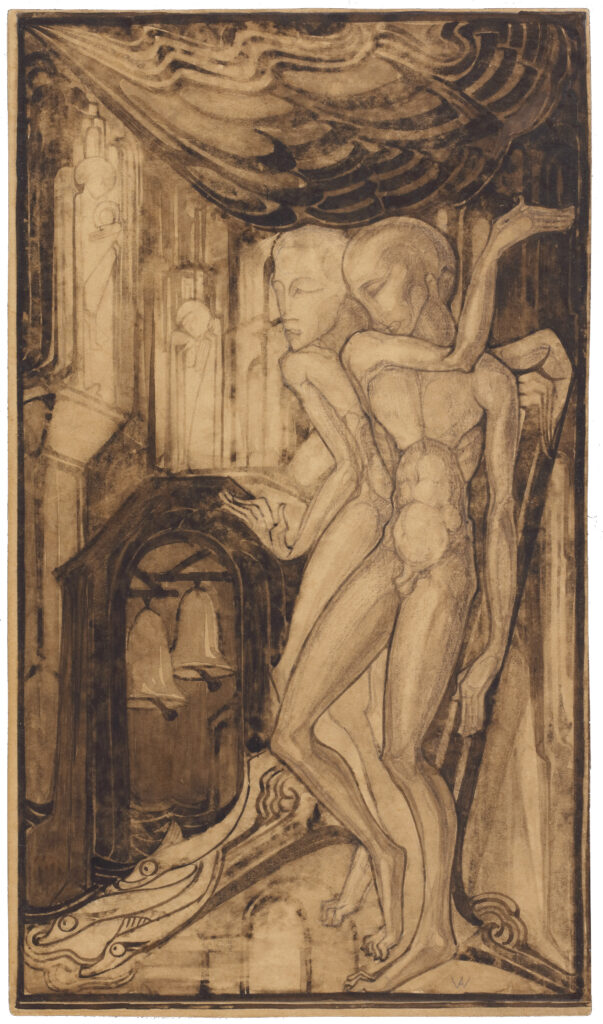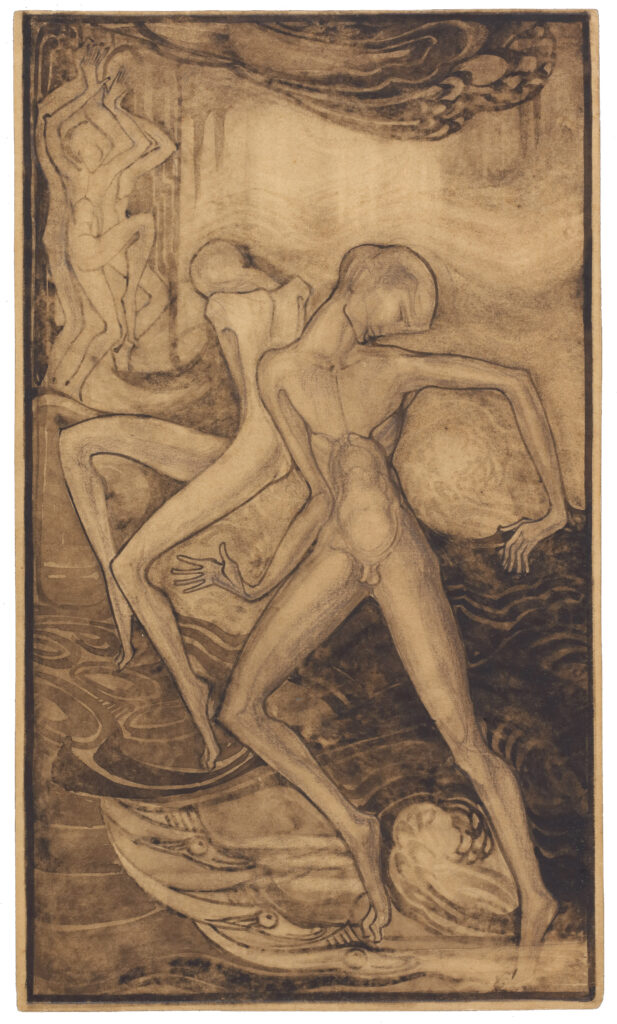At the forthcoming Salon du Dessin in Paris, Onno van Seggelen Fine Arts will be offering two very fine drawings by Willem Arondéus. As the period and subject matter are closely related to this site and my own research, I was privileged to write an article about them for Van Seggelen’s catalogue. It can be found on his site and now here below the pictures as well.

Male Nudes in Church Interior. To be dated 1914-’20. Monogrammed in ligature ‘WA’ below right. Graphite, pen and brown ink, brush and black and brown ink, black and brown wash, partially stenciled (for the very subtle background) 35.8 x 20.8 cm.

Dancing Male Nudes in Landscape. To be dated 1914-’20. Graphite, pen and brown ink, brush and black and brown ink, black and brown wash, partially stenciled (for the very subtle background) 35.9 x 21.1 cm.
**
Nowadays Arondéus is best known for leading, together with Gerrit van der Veen, the bombing of the Amsterdam registry office in March 1943 to destroy the identity papers of Jews and others persecuted by the Nazis. Although only partially successful, it was an important moment for the Dutch resistance, giving people hope that something could actually be done against the German occupation. Fourteen participants, including Arondéus and Van der Veen, were arrested and sentenced to death. Van der Veen managed to escape but was later arrested and executed on 10 June 1944. Arondéus and eleven others were executed on 2 July 1943.
In spite of Arondéus’ important role and courage, Van der Veen is given more credit in the historiography of the Second World War. According to many, the reason for this may have been that Arondéus was openly gay. Shortly before his execution, Arondéus told a friend to ’tell the world that homosexuals are no less courageous than anyone else’. A fact that was still hard for many people to accept. In 2023, Stephen Fry brought Arondéus his well-deserved justice with his impressive Willem and Frieda: Defying the Nazis. Arondéus’ decorative and applied arts are relatively well known. In the documentary Fry is surprised to discover that Arondéus was also a very great artist in his own right. At the Rijksmuseum he admires Arondéus’ drawing based on Georges Eekhoud’ groundbreaking gay novel Escal-Vigor (1899).
The recently discovered two large drawings, to be dated 1914-1920, are a valuable addition to the small drawn oeuvre of Arondéus, aside of the group of Eleven drawings for P.C. Boutens’ unpublished edition of the Rubáiyát of Omar Khayyám we sold to the Rijksmuseum in 2022.[1] The homo-erotic nature of these works is undeniable and are another testimony to Arondéus’ courage. He thus joins a small group of Dutch outsider artists from this period, consisting of Léonard Sarluis, Carel de Nerée, René Gockinga or Albert A. Plasschaert, who were also more or less openly homosexual and/or created work that due to for example androgynous themes can be characterized as queer or at least non-heteronormative.
Richard Roland Holst, Willem van Konijenburg and Aubrey Beardsley were the artists Arondéus most admired. Literature was a very important source for Arondéus’ art. His literary heroes were Oscar Wilde and Jacob Israel de Haan who had published two controversial homosexual novels: Pijpelijntjes (1904) and Pathologieën (1908). In 1917, Arondéus unsuccessfully tried to sell some drawings to De Haan.
In addition to Boutens, he also based drawings on poems by Baudelaire, Martinus Nijhoff, J.H. Leopold and others. Arondéus’ also designed the cover for the gay novel Anders (‘Different’) published by J.F. Francois in 1918 under the pseudonym Charley van Heezen. It is also courageous because it is the first Dutch novel to take a more positive view of homosexuality. The form of the naked male figure on the cover is to somewhat similar to the men on the drawings offered here. No literary source could be found for these drawings. However, they are probably free work based on his own (erotic) imagination, as most of Arondéus’ drawings based on literature contain texts from the source.

According to biographer Rudi van Dantzig, Arondéus made many drawings in the years around 1914-’20 when he lived in Blaricum. Many of them later disappeared though when he moved houses. Arondéus is also said to have destroyed some of them himself because he was unsure of his artistic abilities. It is possible that he realized that this kind of homoerotic work could not be shown in the Netherlands anyway. See also the text accompanying Carel de Nerée’s drawing in this catalogue. With literary drawings, he could hide behind the original texts when he drew naked men to make it less ‘suspicious’. Free work like this was thus riskier.
It is not known whether Male Nudes in a Church Interior and/or Dancing Male Nudes in a Landscape were ever exhibited. Arondéus did exhibit during these years. He participated in major exhibitions where artists such as Mondrian, Charley Toorop or Leo Gestel were also represented. As far as we know, Arondéus also participated with paintings and not with this kind of drawings which were considered ‘decadent’: a nineteenth-century euphemism for queer and non-heteronormative art and literature. Hypothetically, they may have been exhibited in July 1916 in The Hague at the progressive art gallery d’Audretsch, which also held exhibitions by Gockinga and De Nerée during these years. In a review of this exhibition, the NRC mentions ‘Willem Arondéus fijntonige mystische aquarellen’ (‘refined mystical watercolors’).
Whichever way you look at it, these are beautiful and very rare works of great art by a very talented but mostly overlooked major queer artist.
Sander Bink
[1] Willem Arondéus, Eleven drawings for P.C. Boutens’ unpublished edition of the Rubáiyát of Omar Khayyám.
Rijkprentenkabinet, Rijksmuseum, Amsterdam, inv. no’s RP-T-2022-407-1 t/m RP-T-2022-407-11

Ken je het Parelduiker-boekje van Marco Entrop: Van een hooghartige en koele schoonheid. De poëzie-illustraties van Willem Arondeus, 2023?